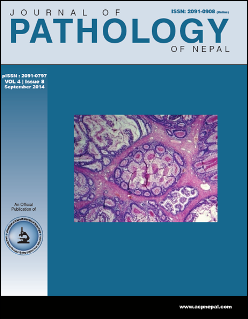Evaluation of AgNoR scores in aspiration cytology smears of breast lesions and their correlation with histopathology
DOI:
https://doi.org/10.3126/jpn.v4i8.11592Keywords:
AgNOR, SAPA, Carcinoma, Invasive ductalAbstract
Background: Breast cancer is the leading cause of cancer-related deaths in Asia. The number of intra-nuclear silver stained structures, termed AgNORs, is significantly higher in malignant cells than in normal, reactive or benign cells. The main purpose of this study was to evaluate the AgNOR scores in aspiration cytology smears of breast lesions and their correlation with histopathology.
Materials and Methods: This was a prospective study conducted over a period of 24 months from October, 2009 to 2011. A total of 40 cases were included in the study, including fine needle aspiration and biopsy. AgNOR stain was done in both cytology and histopathology slides and scoring was done and analyzed.
Results: The mean AgNOR counts were 1.734 for benign cases and 4.508 for malignant cases. Statistically significant ‘P’ value < 0.05 for both benign and malignant cases was observed. The AgNOR dots morphology was homogenous, symmetric with regular contours in both FNAC and histopathology slides of benign breast lesion. In malignant breast lesions, the dots were asymmetric with irregular contours and were aggregated, smaller and more scattered
Conclusion: The mAgNOR counts were significantly higher in smears from malignant breast lesions than in those from benign. These results were similar to those obtained for tissue sections and were comparable to established data. Both AgNOR counts and SAPA score gave similar results done in this study, indicating that SAPA is also as convenient, reproducible and rapid method of AgNOR evaluation.
DOI: http://dx.doi.org/10.3126/jpn.v4i8.11592
Journal of Pathology of Nepal; Vol.4,No. 8 (2014) 649-653
Downloads
Downloads
Published
How to Cite
Issue
Section
License
This license enables reusers to distribute, remix, adapt, and build upon the material in any medium or format, so long as attribution is given to the creator. The license allows for commercial use.




